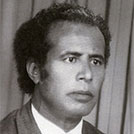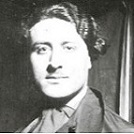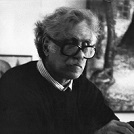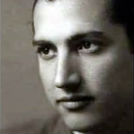| G |
|
 | Jilali Gharbaoui was born in 1930 in Jorf El Melh, Sidi Kacem region, Morocco. He was found dead on a public bench on 8 April 1971 in Paris. Gharbaoui studied at the Ecole des Beaux-Arts of Paris and was introduced as part of the "groupe des informels" at the Salon Comparaison in 1959 by art critic Pierre Restany. In Gharbaoui's short lifetime, he played a major role in furthering the debates around Moroccan modernism. Along with Ahmed Cherkaoui, Jilali Gharbaoui is considered one of the founders of modernism in Morocco. Although Gharbaoui worked with both sculpture and painting, he is best known for the striking colors and violent brush-strokes of his gestural abstractions on canvas, paper, and wood. The paintings deliberately highlight the hand of the artist and often build up texture through thick layers of paint, showcasing both the interplay of colors and lines as well as the materiality of the paint itself.
Read more |
|
 | Cesar Gemayel, born on 9 February in 1898 in ‘Ain al-Touffaha, Lebanon, was a pioneer of Lebanese modernism. His work marks a transition from the commissioned, academic portraits of his predecessors to the portrayal of landscapes, nudes, and still lifes in oil, watercolor, and pastel and characterized by an experimentation with the light, color, and loose brushstroke in the tradition of European Impressionism. He exhibited abroad and in Lebanon, receiving First Prize at the Exposition Coloniale in Paris (1930) and the Lebanese National Order of the Cedar. He was a founding faculty member of the department of Art and Architecture at L’Académie Libanaise des Beaux-Arts. Gemayel died in 1958 in Beirut, Lebanon.
Read more |
|
 | Paul Guiragossian was born on December 25, 1925. He is one of the region's most celebrated artists. His works move between abstraction and figuration to capture the essence of the human form. His large body of portraits includes those of family and self, anonymous figures, and mother and child compositions. In his most distinctive works, Guiragossian uses vertical brushstrokes to abstract and elongate the figural body so that the imagery recalls Byzantine and Christian icons. During the fifties, he began producing completely abstract paintings. Applying color in blocks to the canvas, Guiragossian then left parts of the surface untouched, generating depth and movement through the use of negative space. Guiragossian died on November 20, 1993 in Beirut, Lebanon.
Read more |
|
 | Abdel Hadi el-Gazzar is considered a leader of postwar Egyptian painting. Born in Alexandria in 1925 and raised in Cairo, el-Gazzar joined the Cairo School of Fine Arts in 1945 and formed the Contemporary Art Group under the tutelage of Hussein Yusuf Amin. El-Gazzar first began painting in a folk style, influenced by Surrealism, Cairo's urban landscape, and its multiple religious communities. Dubbed "Popular Mythologies," this early style employs popular and mystical religious themes in a legible figurative style. In 1958, el-Gazzar enrolled at the Central Restoration Institute in Rome, Italy. Once immersed in this European artistic and scientific study, his painting shifted from images of urban Cairo to images of space travel, complex technologies, and impossible machines. This transition is represented by his most famous work, al-Mithaq [The Charter] (1962). At his death in 1966, he was teaching at the Cairo School of Fine Arts, and he continues to be a well-respected leader of the postwar era in Egypt.
Read more |
